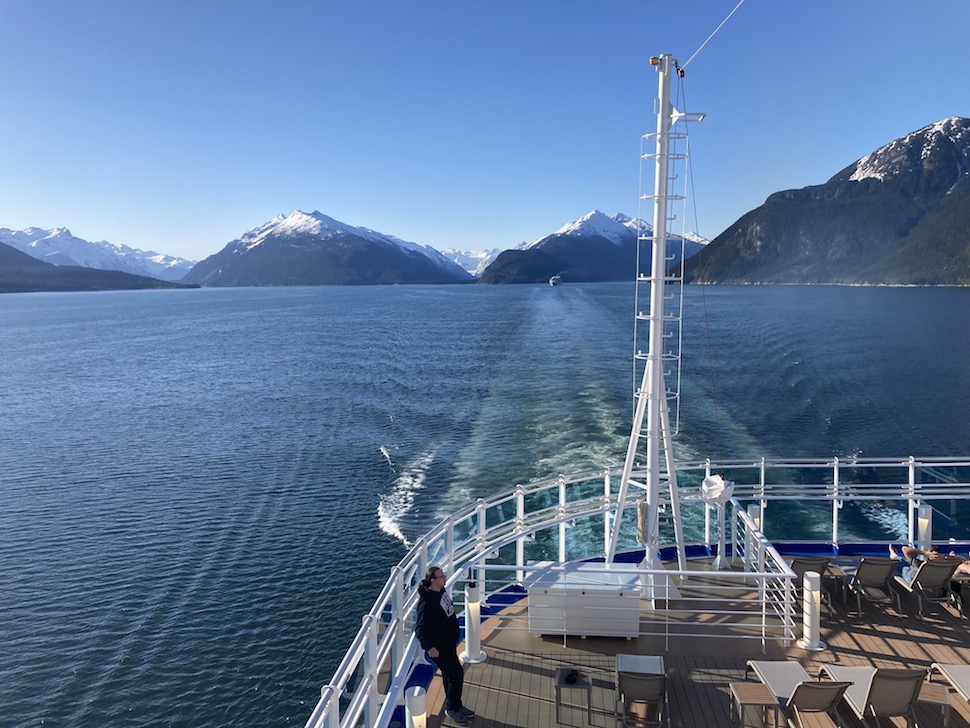
Cruise ship spas are among the most solidly booked spas anywhere. But before we look at the spa experience, we had to confront a larger prejudice: Why go on a cruise at all?
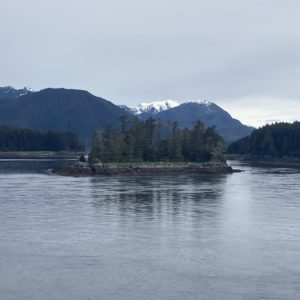 Like many people, Alaska was high on my bucket list. It’s the last American frontier, a grand and amazingly beautiful land that still hollers “rugged adventure!” But I gradually erased Alaska from my list. Why? The story I told myself is that I was a rugged adventure writer. I rated adventures by their Pucker Factor, a scale from 1 to 10. As I wrote long ago in Sports Illustrated, “A PF-10 can be a near-mythical achievement, but more often it is merely terminal. Skydivers earn a 10 when both chutes fail, you are gyrating wildly at 120 mph, heading straight down, and fear puckers your sphincter with such force that your eyeballs pop out of your head before you “bounce.” Reporting such stuff was great fun, as was writing opening lines like, “No shit, there I was! Pucker factor 9!” But as I gave up that kind of adventuring, I gave up my dream of Alaska. The last thing I thought I would do is go to Alaska with a couple thousand strangers on a 1,083-foot cruise ship called Discovery Princess. That struck me as a potential PF 11: an adventure where you just wish you were dead. Then I had an awakening. And if you’re a person who would never consider a cruise to Alaska, you might find my awakening helpful. If so, read on.
Like many people, Alaska was high on my bucket list. It’s the last American frontier, a grand and amazingly beautiful land that still hollers “rugged adventure!” But I gradually erased Alaska from my list. Why? The story I told myself is that I was a rugged adventure writer. I rated adventures by their Pucker Factor, a scale from 1 to 10. As I wrote long ago in Sports Illustrated, “A PF-10 can be a near-mythical achievement, but more often it is merely terminal. Skydivers earn a 10 when both chutes fail, you are gyrating wildly at 120 mph, heading straight down, and fear puckers your sphincter with such force that your eyeballs pop out of your head before you “bounce.” Reporting such stuff was great fun, as was writing opening lines like, “No shit, there I was! Pucker factor 9!” But as I gave up that kind of adventuring, I gave up my dream of Alaska. The last thing I thought I would do is go to Alaska with a couple thousand strangers on a 1,083-foot cruise ship called Discovery Princess. That struck me as a potential PF 11: an adventure where you just wish you were dead. Then I had an awakening. And if you’re a person who would never consider a cruise to Alaska, you might find my awakening helpful. If so, read on.
What happened is that my wife Mary was invited to check out the spa on the newly christened Discovery Princess—and that meant either a weeklong cruise to Mexico in winter or Alaska in summer. Mary didn’t want to go alone, and that was enough to get me to read through the Alaska shore excursions and confront something disconcerting: The kind of exotic adventure activities that I once wrote about for magazines like S.I. and Outside are standard fare on an Alaska cruise. You can paddle to a glacier or fly in by helicopter; you can get up close to whales in a small boat or a seaplane; you can jet boat upriver through rapids and eat salmon baked on traditional skewers The list goes on—enough to fill many incarnations worth of bucket lists—and all these adventures promise to get you back aboard ship in time to dress for drinks, dinner, and a show.
How could that be? What did it mean?
The kind of exotic adventure activities that I once wrote about for magazines like S.I. and Outside are standard fare on an Alaska cruise.
Equally intriguing and disconcerting were the universal “Ocean Medallions” of the Princess Discovery, a “Medallion Class” ship. The Ocean Medallion is a RFID tracker about the size of a poker chip that you wear as a necklace or a bracelet. Like a court-ordered ankle bracelet, the medallion tells the cruise ship exactly where you are aboard ship, but the medallion also links to an app on your phone that allows you to tell the crew what you want, whenever and wherever you want it. Weeks before you travel you’re asked to download the app and enter your passport info, vaccination records, photo, credit card, and some personal preferences, and then Princess mails you your medallion so you are cleared to board before you even leave home.
So, I wondered, will this level of surveillance feel creepy? Or is this the Big Brother I always wanted? Why not find out?
One Morning in May
So, one beautiful morning in May, Mary and I took an Alaska Airlines flight to SeaTac and then caught a Lyft to the Homewood Suites in downtown Seattle. Princess wants their guests to arrive the day before the cruise begins to ensure that nobody misses the boat, and what that meant for us was a marvelous afternoon of meandering downtown. We walked from our hotel to the Olympic Sculpture Garden and then up to the Space Needle and Frank Gehry’s Museum of Pop Culture, a beguilingly weird building beside one of the most enticing playgrounds I’ve ever seen. Later we realized that the pattern of ship and shore excursions is set up even before you get near the ship. Someone had thought this through.
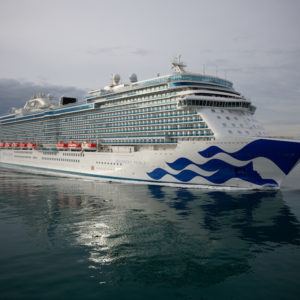
Discovery Princess at sea; photo courtesy Princess Cruises
The next morning, we donned our medallions and caught the five-minute shuttle to the port. A couple thousand people had just gotten off the Discovery Princess’ very first cruise to Alaska, and now about 2,500 were going aboard for the second. It could have been like O’Hare before Christmas; instead, thanks to the medallion, getting through security and boarding the ship was as fast as TSA Pre-Check on a good day. We just waved our medallions over the sensor, got a green light, and went on through. Amazing.
Looking at the line also dispelled an old prejudice. I thought of cruisers as old and round, but our fellow passengers were as varied as at SeaTac: couples and groups of different ages, shapes, colors, and genders. Everyone seemed to speak English, but there were many accents and other languages spoken on the side.
Then something remarkable happened: As we approached our stateroom, our steward, Alvin, greeted us cheerfully by name and when we reached our door it was already unlocked, with a green light and my name on the small screen because I happened to get there before Mary. The medallion had struck again!
Pacing is Important
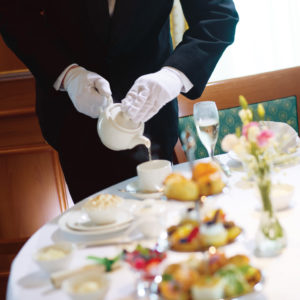
Afternoon tea; photo courtesy Princess Cruises
Our Balcony Class stateroom was a basic rectangle straight from a nice hotel but smaller—just large enough to not feel cramped—and it had a sliding glass door onto a balcony with a pair of comfortable chairs and a small table. The room servicing proved first rate. The medallions let the steward know when we left, so clean up and turn down happened as if by magic. Our first meal aboard was in one of the three main dining rooms, and I imagined we’d wait in line for some group table experience. But when we showed up for our reservation we were again greeted by name and ushered to a private table by a window and given menus with tantalizing choices among what proved to be really good food. We had the Premium Beverage option, which essentially meant an unlimited supply of cocktails, wine, and whatever. One lesson we soon learned is that there is no such thing as scarcity. That lesson came from arriving late for high tea and actually finding a line. The dining room was full and I feared the food service was ending so I took several treats from the first tray—only to be offered treats from another six different trays before the first try came around again. Pacing is important.
Travel writers tend to be treated very well, but so it seemed was everyone else. Part of the reason is that the medallions make everything so efficient that you rarely have to wait for anything. Also, because the medallion gives each guest a name and an identity—and all the accounting and financial transactions take place in the cloud—the staff is able to concentrate on personalized service. It was also clear that the crew was very happy to be back at work after the pandemic. While sitting over desert and decaf cappuccino, I said to Mary, “I could get used to this.” And I did.
Watching the Scenery Go By
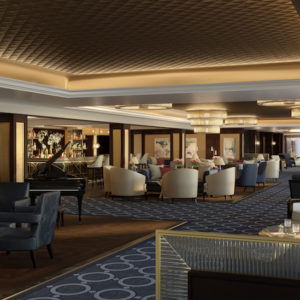
The Crown Grill Bar and restaurant was our favorite; photo courtesy Princess Cruises
On board was a casino and karaoke bar, as well as comedy shows and jewelry auctions and art auctions and all kinds of other group things that we had no interest in and didn’t do. What we did do is sleep late and drink coffee in bed and listen to good live music and dance and stroll around the deck and shoot baskets and putt golf balls and steam in the hammam and eat lots of good food and drink lots of wine and watch the scenery go by. To my surprise, the fitness center even had a couple of Concept 2 rowing machines, the kind of machines I’ve trained on for 40 years, so I kept rowing like at home to burn off the extra calories, but for the first time I could row while watching icebergs float by through the floor to ceiling windows. It’s not often that a rowing machine workout feels glorious.
We also went on shore adventures, and at the first port, Ketchikan, my first choice, a Zodiac wilderness river adventure, was cancelled by rain, so I went on a tour boat through some fiords. The adventure writer in me still wanted to go upriver, knowing that speeding upriver in an open boat through cold, driving rain would really suck, but the more it sucked the better the adventure. I shared that thought with the guide on the fiord tour and she grinned. “In Ketchikan, an avocado costs five bucks,” she said. “What that means is that we need tourists to have a great time. People freezing in the rain doesn’t help, but when it rains, the waterfalls in the fiords are spectacular.” That proved to be true. Then the sun poked out and . . . Wow!
A Harvest of Great Stories
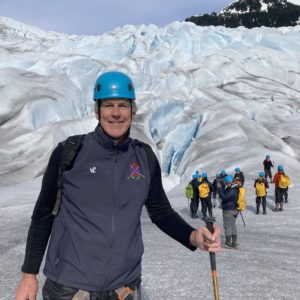
The author on Mendenhall Glacier
I gradually realized that our cruise was a harvest of great stories. Discovery Princess has the classic romance stories built on board: the French bistro, Italian trattoria, sushi bar, jazz club, Champagne on the balcony, breakfast in bed—stories staged on a moving set through some of the world’s most spectacular scenery—and now remarkably personalized by RFID technology.
The Alaskan ports of call—Ketchikan, Juneau, and Skagway—share the same goal. These once wild mining and logging towns now mine their past to attract cruise ships with gold panning and salmon bakes and brothel tours. Our guide on Skagway’s breathtaking narrow-gauge railway said that about 50,000 people joined the Klondike gold rush, but only a few hundred made money, and more than that died. The vast majority of those who joined the stampede just got great stories. Nowadays, it’s not gold but the stories that keep these places alive.
And these towns offer grand adventure stories without the pucker factor. In Juneau, for example, I paddled in a 12-person canoe to the base of the Mendenhall Glacier, donned my crampons, and climbed up beside a crevasse that—as if on cue—calved a large chunk of ice that fell with a resounding crash. Terrifying? Not at all. This adventure was on an entirely different scale: “No shit, there I was! Pleasure Factor 9!”
Stephen Kiesling
Stephen Kiesling is a writer and editor whose career was launched in 1982 with the classic rowing book The Shell Game and The New York Times Book Review, “Just as it is good that there was a riverboat pilot who could write…it is good that there is one true blue jock who can.” A Scholar of the House in philosophy at Yale, Stephen was a 1980 Olympic oarsman who also raced in the 2008 Olympic Trials. He learned journalism from T George Harris, a decorated World War II artillery scout and Time reporter who created Psychology Today. T George and Stephen launched both American Health magazine and Spirituality & Health, where Stephen continues as Editor at Large. He has written for the New Yorker, Sports Illustrated and Outside, was a spokesman for Nike, started a celebrated rowing club, and has built parks and playgrounds. He lives at Ti’lomikh Falls on the Rogue River in southern Oregon, where he writes for his wife Mary Bemis at Insidersguidetospas.com. Stephen is also the caretaker of one of America’s oldest Salmon Ceremonies and is working on a whitewater park and sculpture garden. He is interested in transformational retreats, anything to do with water, the Native American origins of our democracy, and the process of becoming what he calls an Earth-Indigenous Elder, a person who knows their own story from the beginning of time.